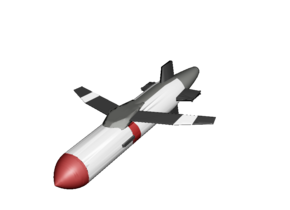RPBG-17K PCS: Difference between revisions
ContraViper (talk | contribs) No edit summary |
ContraViper (talk | contribs) |
||
| Line 40: | Line 40: | ||
It is unknown if the rocket engine is manually ignited on RF-TV guided variants or if the weapons control officer needs to account for this sudden acceleration. | It is unknown if the rocket engine is manually ignited on RF-TV guided variants or if the weapons control officer needs to account for this sudden acceleration. | ||
Once contact is made, the bomb continues to "bury" itself until the fuse triggers the initial explosion several meters (exact number depending on material) underground. The initial explosion consists of a shapecharge, which carves or cracks a hollow, lower-resistance path forward for the follow-through bomb. The follow-through bomb then continues on a forward trajectory penetrating even deeper, before exploding. In this sense, the RPGB-17K can be considered to consist of three penetration phases: 1) kinetic force & time-delayed burying, 2) shape charge formation, 3) follow-through bomb travel & explosive penetration. | Once contact is made, the bomb continues to "bury" itself until the fuse triggers the initial explosion several meters (exact number depending on material) underground. The initial explosion consists of a shapecharge, which carves or cracks a hollow, lower-resistance path forward for the follow-through bomb. The follow-through bomb then continues on a forward trajectory penetrating even deeper, before exploding. In this sense, the RPGB-17K can be considered to consist of three penetration phases: 1) kinetic force & time-delayed burying, 2) shape charge formation, 3) follow-through bomb travel & explosive penetration. <br> | ||
Because of the strategic nature and low-production number of the RPGK-17K, its final warhead payload is customizable. For example, the final follow-through bomb could be a secondary shape charge for deeper penetration, or a thermobaric warhead with an "air sensor" to detect empty space such as tunnels or bunker space allowing it to take out enemy personnel deep underground. | Because of the strategic nature and low-production number of the RPGK-17K, its final warhead payload is customizable. For example, the final follow-through bomb could be a secondary shape charge for deeper penetration, or a thermobaric warhead with an "air sensor" to detect empty space such as tunnels or bunker space allowing it to take out enemy personnel deep underground. | ||
==Combat History== | ==Combat History== | ||
Only four RPBG-17K PCS have been used. | Only four RPBG-17K PCS have been used. | ||
Latest revision as of 05:06, 29 February 2024
| RPBG-17K PCS | |
|---|---|
 RPBG-17K | |
| Type | Heavy Bunker Buster |
| Place of origin | |
| Service history | |
| In service | 2017-present |
| Used by | |
| Production history | |
| Designer | Morales-Sevalière Design Bureau (MSDB) |
| Designed | 2015 |
| Specifications | |
| Weight | 7,700kg (17,000lb) |
| Warhead | 2-Stage Warhead |
Detonation mechanism | Delayed Fused |
Operational range | >60km (estimated) |
Guidance system | GPS or Radio-Frequency TV-Guided |
The RPBG-17K PCS (Pénétrataire Conventionèle Stratégiquo) is a heavyweight, rocket-propelled glide bomb in service with the Inyurstan Aeroforca. It is designed to engage "strategic bunkers", which would house something such as enemy leadership, nuclear weapons or other underground fortified positions. As of date, it is the largest bomb in the arsenal of the Inyurstan Armed Forces.
Operation
Functioning as a glide bomb, the RPBG-17K has a pair of built-in folding wings which assist its stable descent in-"flight". Unlike other rocket-propelled glide bombs, the rocket engine on the RPGB-17K does not initiate until the terminal descent. Terminal rocket acceleration is added to provide greater kinetic power behind the already heavy warhead to aid in deep penetration below the surface. It is unknown if the rocket engine is manually ignited on RF-TV guided variants or if the weapons control officer needs to account for this sudden acceleration.
Once contact is made, the bomb continues to "bury" itself until the fuse triggers the initial explosion several meters (exact number depending on material) underground. The initial explosion consists of a shapecharge, which carves or cracks a hollow, lower-resistance path forward for the follow-through bomb. The follow-through bomb then continues on a forward trajectory penetrating even deeper, before exploding. In this sense, the RPGB-17K can be considered to consist of three penetration phases: 1) kinetic force & time-delayed burying, 2) shape charge formation, 3) follow-through bomb travel & explosive penetration.
Because of the strategic nature and low-production number of the RPGK-17K, its final warhead payload is customizable. For example, the final follow-through bomb could be a secondary shape charge for deeper penetration, or a thermobaric warhead with an "air sensor" to detect empty space such as tunnels or bunker space allowing it to take out enemy personnel deep underground.
Combat History
Only four RPBG-17K PCS have been used.